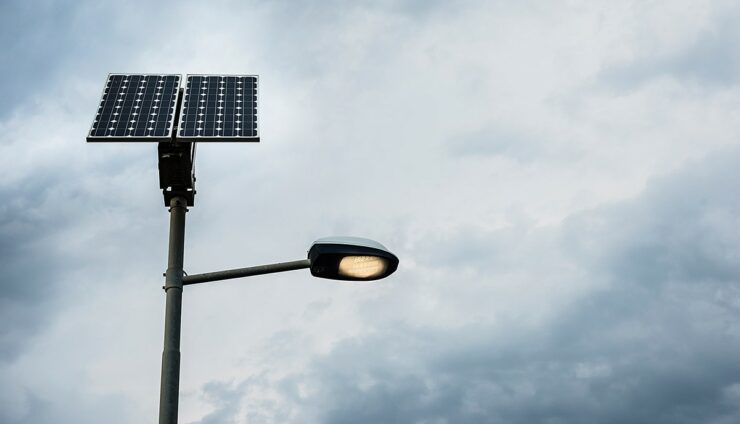Introduction
Solar street lighting has become a popular choice for many cities, towns, and communities looking to make a positive impact on the environment and their budgets. In this article, we will explore the many advantages of solar street lighting and how it can benefit you and your community. So, let’s dive in!
The Advantages of Solar Street Lighting
Environmental Benefits
Reducing Carbon Footprint
One of the most significant advantages of solar street lighting is its ability to reduce your community’s carbon footprint. Unlike traditional streetlights that rely on electricity from fossil fuels, solar streetlights use clean and renewable solar energy. This helps reduce greenhouse gas emissions and combat climate change.
Decreasing Light Pollution
Solar streetlights are designed with directional lighting, which means they focus light on the ground rather than dispersing it into the sky. This helps decrease light pollution, preserving the night sky for stargazers and reducing the impact on nocturnal wildlife.
Economic Benefits
Lower Energy Bills
Since solar streetlights harness energy from the sun, they don’t rely on the electrical grid for power. This means lower energy bills for municipalities and taxpayers, freeing up funds for other essential services and infrastructure projects.
Reduced Maintenance Costs
Solar streetlights are low-maintenance, with fewer moving parts than traditional streetlights. They also use energy-efficient LED bulbs that last longer than traditional bulbs, reducing the need for frequent replacements. This means lower maintenance costs and less hassle for public works departments.
Government Incentives
Many governments offer incentives and rebates for installing solar street lighting, making it even more cost-effective for municipalities to switch. These incentives can help offset the initial investment and accelerate the payback period.
Enhanced Public Safety
Improved Visibility
Solar streetlights often provide better visibility than traditional streetlights due to their high-quality LED bulbs and precise light distribution. This improved visibility makes streets safer for pedestrians, cyclists, and motorists.
Increased Security
Well-lit streets deter criminal activity, and solar streetlights can provide consistent illumination, even during power outages. This increased security helps residents feel safer and more comfortable in their neighborhoods.
Reduced Accident Rates
Better visibility, fewer dark spots, and consistent lighting contribute to safer roads and walkways. This can lead to a reduction in accidents and incidents involving pedestrians, cyclists, and motorists.
Easy Installation and Reliability
Wireless Design
Solar street lights feature a wireless design, making them easy to install without the need for complex wiring or trenching. This means faster installation times and reduced disruption to the community during the process.
Long Lifespan
High-quality solar streetlights have a long lifespan, with LED bulbs typically lasting up to 50,000 hours or more. This longevity means less frequent replacements and improved reliability for your community’s lighting infrastructure.
Grid Independence
Uninterrupted Power Supply
Solar streetlights are not reliant on the electrical grid, so they continue to function during power outages or grid failures. This ensures that streets remain illuminated and safe, even during emergencies or natural disasters.
Rural and Remote Area Applications
Solar street lighting is an ideal solution for rural and remote areas where grid connectivity is limited or unavailable. By using solar power, communities can enjoy the benefits of street lighting without the need for costly grid expansion.
Conclusion
In conclusion, solar street lighting offers numerous advantages, including environmental benefits, economic savings, enhanced public safety, easy installation, and grid independence. By harnessing the power of the sun, communities can enjoy reliable, cost-effective, and sustainable lighting solutions that positively impact both people and the planet.
FAQs
- What is the average lifespan of solar streetlights?
Solar streetlights typically have a lifespan of 25-30 years, with LED bulbs lasting up to 50,000 hours or more.
- Can solar streetlights function during cloudy days or at night?
Yes, solar streetlights are equipped with battery storage systems that store excess energy generated during daylight hours, ensuring they continue to function during cloudy days and at night.
- How do solar streetlights withstand extreme weather conditions?
Solar streetlights are designed to be durable and weather-resistant, capable of withstanding various environmental conditions, including high winds, heavy rain, and temperature fluctuations.
- Are solar streetlights suitable for all climates?
Solar streetlights can function in various climates, but their efficiency may be affected by factors such as extreme temperatures, prolonged cloud cover, or shading from nearby buildings and trees.
- What is the cost comparison between solar and traditional street lighting?
While the upfront cost of solar streetlights may be higher, they offer long-term savings due to lower energy bills, reduced maintenance costs, and government incentives. Over time, the total cost of ownership for solar streetlights is often lower than that of traditional streetlights.


